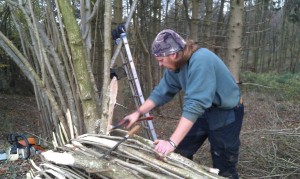I am sorry to say that no one managed to identify last month’s mystery picture,  which showed a section of a binder, which was the machine used for harvesting cereal crops like wheat, oats and barley, for a relatively short period between the days of hand reaping with scythes, and the invention of the combine harvester in the mid twentieth century. A binder can cut and tie in bundles the sheaves of wheat, using twine and the knotting system which is still the basic system used in modern day balers. The sheaves would then be stood in stooks in the field for a period of time, to allow the cut corn to fully ripen in the open air, before being loaded up by hand and carted back to the rickyard, where the sheaves were stacked up into a rick, to await the visit of the thrashing team in the late autumn or winter. This whole protracted operation was of course rendered completely redundant by the arrival of the combine harvester, which cuts and thrashes the crop in one go, and produces a clean sample of grain pretty well ready for the next operation in the food chain.
which showed a section of a binder, which was the machine used for harvesting cereal crops like wheat, oats and barley, for a relatively short period between the days of hand reaping with scythes, and the invention of the combine harvester in the mid twentieth century. A binder can cut and tie in bundles the sheaves of wheat, using twine and the knotting system which is still the basic system used in modern day balers. The sheaves would then be stood in stooks in the field for a period of time, to allow the cut corn to fully ripen in the open air, before being loaded up by hand and carted back to the rickyard, where the sheaves were stacked up into a rick, to await the visit of the thrashing team in the late autumn or winter. This whole protracted operation was of course rendered completely redundant by the arrival of the combine harvester, which cuts and thrashes the crop in one go, and produces a clean sample of grain pretty well ready for the next operation in the food chain.
For the last couple of months, Martin Piper has been laying hedges for us around Roundbush and Websley woods. We are keen to recreate a well stratified border to the woodlands, to provide suitable environments for a wide variety of wildlife species. The ancient hedges surrounding the woods, which were run by the Forestry Commission until about 5 years ago, have got very overgrown and gappy. The idea now is to reinvigorate them by laying, and gapping-up where there is nothing to lay, then to re-fence, to keep the livestock out.
We are fully into the winter routines by now, all the animals are housed or else enjoying haute cuisine (turnips) out in the wind and rain. The ewes have been enjoying the company of a motley collection of rams for the last couple of weeks, I hope you will agree that this fellow just oozes character, and the young ewe in his company fell for his charms this morning, more than once I feel sure. Ewes cycle every seventeen days, and with around 120 ewes in the group, that means an average of 6 ewes cycling every day. Now there is quite a chance that each ewe will be covered by more than one ram on the day she cycles, and as there are four rams in this group one can imagine the field has seen quite a bit of action over Christmas.
I hope you will agree that this fellow just oozes character, and the young ewe in his company fell for his charms this morning, more than once I feel sure. Ewes cycle every seventeen days, and with around 120 ewes in the group, that means an average of 6 ewes cycling every day. Now there is quite a chance that each ewe will be covered by more than one ram on the day she cycles, and as there are four rams in this group one can imagine the field has seen quite a bit of action over Christmas.
There’s a great view from the Knoll across Durweston to Stourpaine, if the Editor has the space to print the following picture large enough, you may be able to spot the church towers of both villages in the same shot shown here.
Who enjoyed Nick Crump’s visit to the village hall at the beginning of December? He played a wonderful array of crazy instruments, mostly constructed himself. He is a remarkable musician, because rather than just stick a piece of hose up the pipe of a lavatory bowl and hope for a funny result, he works out how long the piece of pipe should be so that the instrument works musically, and can actually have a tune played on it. I must say I was very surprised to hear that the lavatory produced a surprisingly high pitched sound, where I had been expecting more of a deep and gutsy blast. This picture shows Nick playing an instrument based on an old ship’s hooter.  In between the funny bits, Nick played some terrific recorder with the Hambledon Hopstep band, we really should have been dancing. It was a tremendous evening by a very talented musician, and Nick was donating all the takings to the Air Ambulance, who had helped him out after an accident earlier in the year.
In between the funny bits, Nick played some terrific recorder with the Hambledon Hopstep band, we really should have been dancing. It was a tremendous evening by a very talented musician, and Nick was donating all the takings to the Air Ambulance, who had helped him out after an accident earlier in the year.
With warmest wishes for 2012, which will be with us in a trice.


